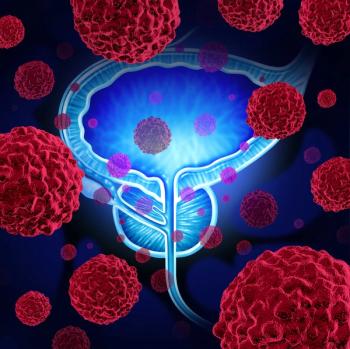
Circulating KIM-1 May Predict Benefit With Atezolizumab in RCC
KIM-1 was the most significantly enriched circulating protein in recurrence vs baseline serum samples among patients in the IMmotion010 trial.
Disease recurrence, minimal residual disease (MRD) status, and clinical benefit with adjuvant atezolizumab (Tecentriq) among those with renal cell carcinoma (RCC) may correlate with the presence of circulating kidney injury molecule-1 (KIM-1), according to retrospective data from the phase 3 IMmotion010 trial (NCT03024996) presented at the
Previously reported topline results from the IMmotion010 trial showed that atezolizumab did not extend disease-free survival (DFS) vs placebo when used as adjuvant therapy post-resection in patients with renal cell carcinoma (RCC) at increased risk of recurrence.2 The median DFS was 57.2 months with atezolizumab vs 49.5 months with placebo (HR, 0.93; 95% CI, 0.75-1.15; P = 0.50).
In her presentation at the ASCO meeting, lead study author, Laurence Albiges, MD, PhD, chair of the medical oncology department at Gustave Roussy Institute in Villejuif, France, explained that the purpose of the retrospective analysis was to use the IMmotion010 data to examine “circulating protein biomarkers to identify high-risk patients with MRD who may show differential benefit from atezolizumab treatment.”1
Albiges said the biomarker analysis revealed that “KIM-1, a type 1 membrane glycoprotein, was the most significantly enriched circulating protein in recurrence vs baseline serum samples in IMmotion010.”
The researchers next looked at baseline characteristics for patients with KIM-1–high status (n = 300) and KIM-1–low status (n = 452). The characteristics, which were well balanced between the 2 groups, included median age (median 64 years in KIM-1–high vs 58 years in KIM-1–low), gender (77% male vs 69% male, respectively), PD-L1 status (positive: 63% vs 59%), and sarcomatoid component (16% vs 11%). Most patients in each group had T2/T3a pathologic disease stage (57% vs 69%) and stage III disease stage (83% vs 86%).
Among patients with KIM-1–high status at baseline, atezolizumab improved DFS vs placebo (median DFS, NE vs 21.16 months; HR, 0.72; 95% CI, 0.52-0.99), while atezolizumab did not improve DFS in patients with low KIM-1 at baseline (median DFS, 57.23 months vs NE; HR, 1.12; 95% CI, 0.88-1.63).
“In the KIM-1–high subgroup, patients were less likely to experience an on-treatment increase in KIM-1 levels with atezolizumab vs placebo,” said Albiges. Among patients with KIM-1–high status at baseline, 9% had an on-treatment KIM-1 increase vs 15% in the placebo group. In the KIM-1 low group, the rates were a 16% increase with atezolizumab vs 14% increase with placebo.
“On-treatment increase in KIM-1 was associated with worse DFS in both the KIM-1–high and KIM-1–low subgroups,” noted Albiges, and “Serum KIM-1 levels increased at the time of disease recurrence vs baseline.”
IMmotion010 background
The double-blind phase 3 IMmotion010 trial (NCT03024996) enrolled 778 patients with RCC at 215 clinical sites across 28 countries between January 3, 2017, and February 15, 2019. Patients had disease with a clear cell or sarcomatoid component and increased risk of recurrence following nephrectomy with or without metastasectomy.
The median patient age was 60 years, 73% of patients were male, and about 80% of patients were White. Overall, 79% of patients had an ECOG performance status (PS) of 0 and 21% had an ECOG PS of 1. Sixty-four percent of patients had stage T2 or T3a disease, and 22% of patients had stage T3b–c or T4 or N+ disease. Forty percent of patients were negative for PD-L1 immune cell expression on their tumors and 60% were positive.
Patients were randomized in a 1:1 ratio to adjuvant atezolizumab (390 patients) placebo (388 patients). Atezolizumab (1200 mg) or matching placebo were both administered intravenously once every 3 weeks for 16 cycles or 1 year. Investigator-assessed DFS in the intention-to-treat (ITT) population was the primary end point.
Next steps
Looking ahead, Albiges said, “Additional validation studies are warranted to confirm the utility of circulating KIM-1 in adjuvant RCC as a noninvasive biomarker for identification of MRD, predicting outcomes to checkpoint inhibitor treatment, and longitudinal monitoring for disease recurrence.”
References
- Albiges L, Bex A, Suárez C, et al. Circulating kidney injury molecule-1 (KIM-1) biomarker analysis in IMmotion010: A randomized phase 3 study of adjuvant (adj) atezolizumab (atezo) vs placebo (pbo) in patients (pts) with renal cell carcinoma (RCC) at increased risk of recurrence after resection.J Clin Oncol 42, 2024 (suppl 16; abstr 4506). doi: 10.1200/JCO.2024.42.16_suppl.4506
- Bex A, Uzzo R, Karam JA, et al. IMmotion010: Efficacy and safety from the phase III study of atezolizumab (atezo) vs placebo (pbo) as adjuvant therapy in patients with renal cell carcinoma (RCC) at increased risk of recurrence after resection. Ann Oncol. 2022;33(suppl 7):S808-S869. doi:10.1016/annonc/annonc1089
Newsletter
Stay up to date on recent advances in the multidisciplinary approach to cancer.

























































































